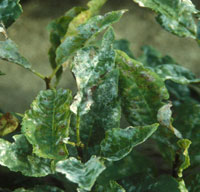Various species
Hosts
Various
Distribution and Disease Cycle

Photo credit: Petr Kapitola, State Phytosanitary Administration, Bugwood.org
Powdery mildew is a widespread fungal disease affecting both vegetative and woody plants. While some trees and shrubs are more susceptible, almost any woody plant can be infected under the right conditions (favoured by shading and high humidity). Typical hosts include lilac, caragana, crabapple, chokecherry or rose.
The pathogen over-winters on fallen leaves, with spores spreading the during wet weather in spring. Following the initial infection, spores are continuously produced and spread by wind and rain to further infect other leaves during warm, humid, summer weather.
Symptoms and Signs

Photo credit: Agroforestry Development Centre
Powdery mildew appears as white or grey dusty patches on leaf surfaces, making plants appear unsightly.
Control
If powdery mildew is a continual problem, rake up and remove all fallen leaves to reduce inoculum for the following spring. Provide good aeration and sunlight to susceptible plants. Chemical control is not usually required, but if infection is severe, a number of fungicides are available for powdery mildew control, including those containing sulphur (crabapple, elder, lilac, rose) myclobutanil (dogwood, lilac, rose), chlorothalonil (crabapple), tryfloxystrobin (crabapple) or thiophanate-methyl (various species). Check labels for specific species recommendations and application instructions.